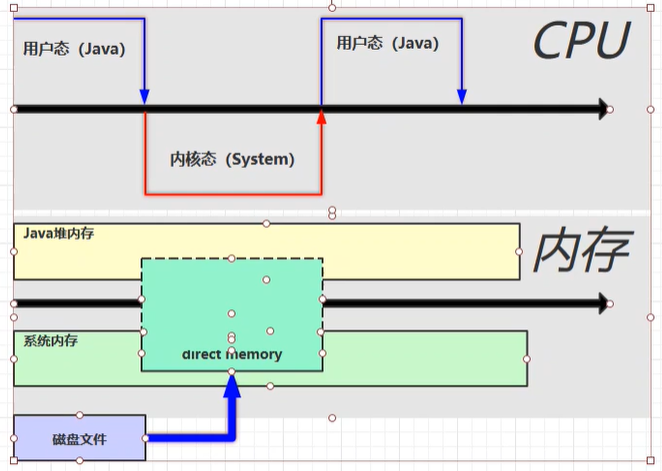内存结构篇:直接内存
一、定义
直接内存(Direct Memory)并不是虚拟机运行时数据区的一部分,也不是《Java虚拟机规范》中定义的内存区域。但是这部分内存也被频繁地使用,而且也可能导致 OutOfMemoryError 异常出现。(即不属于JVM虚拟机内存区域,属于操作系统的内存)
在 JDK1.4 中新引入了NIO类,它可以使用 Native 函数库直接分配堆外内存,然后通过 Java 堆里的 DirectByteBuffer 对象作为这块内存的引用进行操作。这样就能在一些场景中显著提高性能,因为避免了在 Java 堆(堆内存)和 Native 堆(堆外内存)中来回复制数据。
- 常见于 NIO 操作时,用于数据缓冲区
- 分配回收成本较高,但读写性能高
- 不受 JVM 内存回收管理
ByteBuffer.allocateDirect(); //分配直接内存空间
static final String FROM = "E:\\test.mp4";
static final String TO = "E:\\a.mp4";
static final int _1Mb = 1024 * 1024;
public static void main(String[] args) {
io(); // io 用时:1535.586957 1766.963399 1359.240226
directBuffer(); // directBuffer 用时:479.295165 702.291454 562.56592
}
private static void directBuffer() {
long start = System.nanoTime();
try (FileChannel from = new FileInputStream(FROM).getChannel();
FileChannel to = new FileOutputStream(TO).getChannel();
) {
ByteBuffer bb = ByteBuffer.allocateDirect(_1Mb); //分配一块直接内存,系统和java程序都能访问
while (true) {
int len = from.read(bb);
if (len == -1) {
break;
}
bb.flip();
to.write(bb);
bb.clear();
}
} catch (IOException e) {
e.printStackTrace();
}
long end = System.nanoTime();
System.out.println("directBuffer 用时:" + (end - start) / 1000_000.0);
}
private static void io() {
long start = System.nanoTime();
try (FileInputStream from = new FileInputStream(FROM);
FileOutputStream to = new FileOutputStream(TO);
) {
byte[] buf = new byte[_1Mb];
while (true) {
int len = from.read(buf);
if (len == -1) {
break;
}
to.write(buf, 0, len);
}
} catch (IOException e) {
e.printStackTrace();
}
long end = System.nanoTime();
System.out.println("io 用时:" + (end - start) / 1000_000.0);
}
不使用直接内存进行读写:

使用直接内存进行读写:在操作系统划出一个缓冲区作为直接内存,系统和java程序都能访问,减少一个缓冲区的复制操作,加快文件的读写

二、分配和回收原理
- 使用了 Unsafe 对象完成直接内存的分配回收,并且回收需要主动调用 freeMemory 方法
/**
* 直接内存分配的底层原理:Unsafe
*/
public class Demo {
static int _1Gb = 1024 * 1024 * 1024;
public static void main(String[] args) throws IOException {
Unsafe unsafe = getUnsafe();
// 分配内存
long base = unsafe.allocateMemory(_1Gb);
unsafe.setMemory(base, _1Gb, (byte) 0);
System.in.read();
// 释放内存
unsafe.freeMemory(base);
System.in.read();
}
public static Unsafe getUnsafe() {
try {
Field f = Unsafe.class.getDeclaredField("theUnsafe");
f.setAccessible(true);
Unsafe unsafe = (Unsafe) f.get(null);
return unsafe;
} catch (NoSuchFieldException | IllegalAccessException e) {
throw new RuntimeException(e);
}
}
}
- ByteBuffer 的实现类内部,使用了 Cleaner (虚引用)来监测 ByteBuffer 对象,一旦
ByteBuffer 对象被垃圾回收,那么就会由 ReferenceHandler 线程通过 Cleaner 的 clean 方法调
用 freeMemory 来释放直接内存
/**
* 禁用显式回收对直接内存的影响
*/
public class Demo1_26 {
static int _1Gb = 1024 * 1024 * 1024;
/*
* -XX:+DisableExplicitGC 禁止显式的垃圾回收
*/
public static void main(String[] args) throws IOException {
ByteBuffer byteBuffer = ByteBuffer.allocateDirect(_1Gb);
System.out.println("分配完毕...");
System.in.read();
System.out.println("开始释放...");
byteBuffer = null;
System.gc(); // 显式的垃圾回收,Full GC
System.in.read();
}
}


 浙公网安备 33010602011771号
浙公网安备 33010602011771号